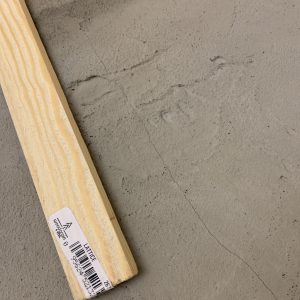I am in the process of installing new tile floor in the bathroom of a mid 50’s era house. The floor of the bathroom was 3/4 plywood with a 1″ mortar bed. I was able to get the original tiles off with only minor damage to the mud bed so I decided to keep it. Unfortunately, the subfloor around the toilet was pretty crummy, so I ended up cutting a 2×4 foot section of the floor around the toilet out (mud bed and plywood) leaving only the floor joists which are 16″ OC.
To build things back, I laid down 3/4″ exterior plywood and fastened to the joists followed by 1/2″ exterior plywood fastened to the 3/4″ plywood (but not into the joists). I then applied a layer of Laticrete NXT patch to fill in gaps and bring the new subfloor level with the mud bed. For the NXT patch, I used the specified amount of water and did not use any additives. This is where I ran into a snag. After letting the floor cure for a few days, I came in to inspect and clean things up before moving to the next phase. I quickly noticed a number of hairline cracks running across the area where I had patched!! Before that point, I barely walked on the floor and definitely did not jump up and down on it.
Before going with the nuclear option and completely ripping things up to start from scratch, I wanted to check here first for a second opinion. I have never used this product before. Are hairline cracks expected during the curing process? On the package, the product states that it is designed for patching from 1/8″ to 1.25″. In a few places the floor was pretty shallow and its possible that I only got 1/8″ of depth (possibly a little less). Would that cause the cracking? If so, could I use something like Henry 5xx skim coat and skim-coat the whole floor to fill the hairline crack (assuming they were only cosmetic)?





















Replies
Did you maintain the required temperature in the room during application and throughout the curing period?
Yes, the house was between 65 and 70 F during application and curing.
That could be a simple shrinkage crack from drying out too quickly which would not be a big deal. If it were some sort of flexing or structural crack I would expect it to be bigger and to open up some when you put weight onto it.
You definitely want to add a crack suppresion membrane beneath the tile. (It will help with waterproofing too) there are a bunch of different manufacturers but a lot of people like Schluter.
The cracks appeared around the perimeter was too dry when concrete was placed. Next time brush water on existing dry surface before patching. For the hairline cracks, completely dry the surface, then brush and poke in dry cement and vibrate as much you can into crack. Then moisten.
I wanted to circle back on this post to provide an update. As I completed the tile job and installed the vanity, I discovered a heat duct directly below where the cracks were appearing. So I think sawdust_steve had it correct, the the area in question was getting much warmer than the surrounding leveler leading to the appearance of cracks.It has been roughly a year now and no cracks have appeared in the tile work much to my relief. Thanks for everyone's opinions.
Thank you for the return and information!
I used a concrete wheel on the angle grinder (because its what I had). It theoretically is nowhere close to the V-wheel, but it did well. It was in a basement, and it got very dusty even with a vacuum right behind it.
No, you shouldn't expect tiny cracks to form during the drying process. You might have only gotten 1/8" of depth, which could have led to the cracking. You can try to fill in the cracks with a skim coat like Henry 5xx.
Hairline cracks can sometimes occur during the curing process of patching compounds like Laticrete NXT patch. However, it's important to assess the severity and extent of the cracks to determine the best course of action. If the cracks are shallow and only cosmetic, you may consider using a skim coat product like Henry 5xx to fill in the cracks and provide a smoother surface. However, if the cracks are deep or widespread, it could indicate a structural issue with the subfloor or improper installation of the patching compound.